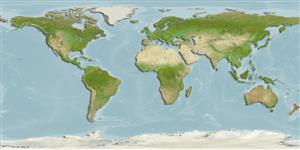Environment: milieu / climate zone / depth range / distribution range
Ökologie
seewasser riff-verbunden; tiefenbereich 0 - 70 m (Ref. 89444), usually 15 - 35 m (Ref. 28787). Deep-water
Southwestern Pacific: Restricted to New Zealand.
Size / Gewicht / Alter
Maturity: Lm ? range ? - ? cm
Max length : 11.3 cm SL Männchen/unbestimmt; (Ref. 76814)
Nocturnally active; inhabits cracks and crevices during the day. Feeds on small mobile benthic organisms (Ref. 26966), by drifting up to its prey and swallowing it whole with a sideways snap of the large extensible mouth (Ref. 26966).
Life cycle and mating behavior
Geschlechtsreife | Fortpflanzung | Ablaichen | Eier | Fecundity | Larven
Robins, C.R., R.M. Bailey, C.E. Bond, J.R. Brooker, E.A. Lachner, R.N. Lea and W.B. Scott, 1991. World fishes important to North Americans. Exclusive of species from the continental waters of the United States and Canada. Am. Fish. Soc. Spec. Publ. (21):243 p. (Ref. 4537)
IUCN Rote Liste Status (Ref. 130435: Version 2024-1)
Bedrohung für Menschen
Harmless
Nutzung durch Menschen
Fischereien: nicht kommerziell
Tools
Zusatzinformationen
Download XML
Internet Quellen
Estimates based on models
Preferred temperature (Ref.
123201): 16.6 - 23.2, mean 17.9 °C (based on 28 cells).
Phylogenetic diversity index (Ref.
82804): PD
50 = 0.6250 [Uniqueness, from 0.5 = low to 2.0 = high].
Bayesian length-weight: a=0.00955 (0.00451 - 0.02020), b=2.99 (2.80 - 3.18), in cm total length, based on LWR estimates for this species & (Sub)family-body (Ref.
93245).
Trophic level (Ref.
69278): 3.5 ±0.5 se; based on diet studies.
Widerstandsfähigkeit (Ref.
120179): niedrig, Verdopplung der Population dauert 4,5 - 14 Jahre. (Preliminary K or Fecundity.).
Fishing Vulnerability (Ref.
59153): Low vulnerability (10 of 100).
Nutrients (Ref.
124155): Calcium = 5.14 [2.35, 16.48] mg/100g; Iron = 0.179 [0.071, 0.452] mg/100g; Protein = 17.9 [16.5, 19.3] %; Omega3 = 0.173 [0.062, 0.470] g/100g; Selenium = 8.29 [2.99, 22.55] μg/100g; VitaminA = 45.9 [8.0, 292.4] μg/100g; Zinc = 0.505 [0.291, 0.834] mg/100g (wet weight);
